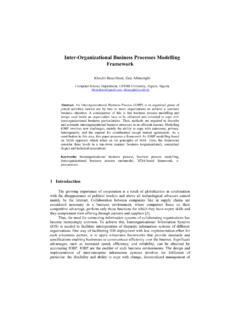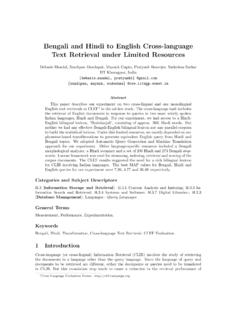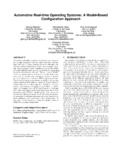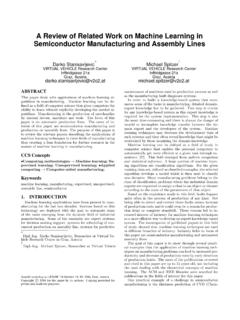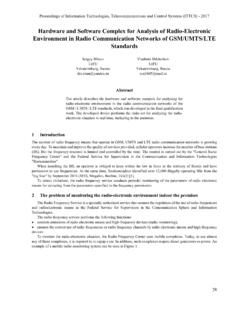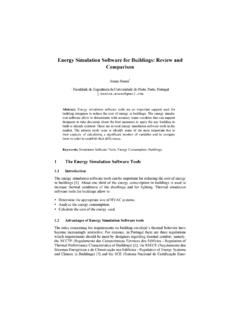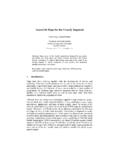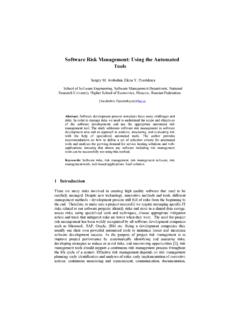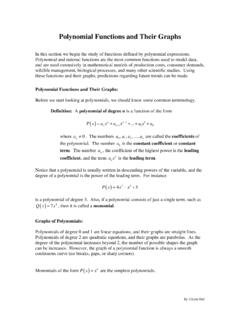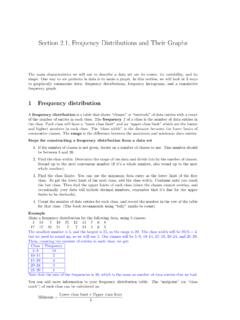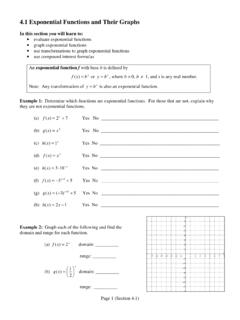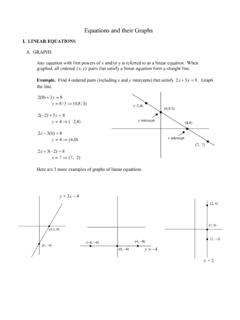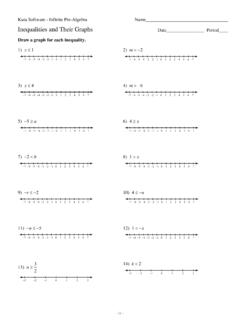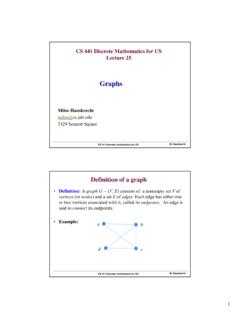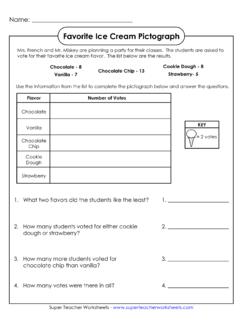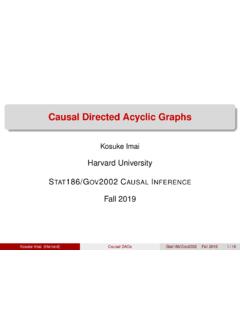Transcription of Towards a Definition of Knowledge Graphs - CEUR-WS.org
1 Towards a Definition of Knowledge GraphsLisa Ehrlinger and Wolfram W Institute for Application Oriented Knowledge ProcessingJohannes Kepler University Linz, Austria{ | the termknowledge graphhas been used frequentlyin research and business, usually in close association withSemantic Web technologies, linked data, large-scale dataanalytics and cloud computing. Its popularity is clearly in-fluenced by the introduction of Google s Knowledge Graphin 2012, and since then the term has been widely used with-out a definition. A large variety of interpretations has ham-pered the evolution of a common understanding of knowledgegraphs. Numerous research papers refer to Google s Knowl-edge graph , although no official documentation about theused methods exists. The prerequisite for widespread aca-demic and commercial adoption of a concept or technology isa common understanding, based ideally on a definition thatis free from ambiguity.}
2 We tackle this issue by discussingand defining the term Knowledge graph , considering its his-tory and diversity in interpretations and use. Our goal is topropose a definition of Knowledge Graphs that serves as basisfor discussions on this topic and contributes to a Concepts Information systems Data management systems; In-formation systems applications;KeywordsKnowledge Graphs , Knowledge Bases, Ontologies, KnowledgeRepresentation, Semantic INTRODUCTIONC onsiderable research into Knowledge Graphs (KGs) hasbeen carried out in recent years, especially in the SemanticWeb community, and thus a variety of partially contradictingdefinitions and descriptions has emerged. The often quotedblog entry by Google [18] basically describes an enhancementof their search engine with semantics.
3 And also Wikipedia,the most comprehensive encyclopedia in the web, does notprovide information about Knowledge Graphs in general, butrefers to the implementation by Google without mentioningthe existence of other Knowledge Graphs . Although Wikipediais no scientific reference source, it contributes to a commonunderstanding through its role as a primary informationc 2016 Copyright held by the author/owner(s).SEMANTICS 2016: Posters and Demos TrackSeptember 13-14, 2016, Leipzig, Germanysource for several prominent Knowledge representation ap-plications. Other definitions may lead to the assumptionthat Knowledge graph is a synonym for any graph -basedknowledge representation (cf. [12, 16]). We argue that sucha definition is not enough for an adequate application ofknowledge Graphs , since it does not enforce a minimum setof requirements a KG has to fulfill.
4 Thus, even a simplegraph-based vocabulary could be published as knowledgegraph. In addition, such a definition creates an entrancebarrier for people who are unfamiliar with Knowledge graphsand want to delve deeper into the topic or aim at buildinga KG on their own. A clear definition propagates a sharedunderstanding of benefits, improvements, or drawbacks thatcan be expected if someone builds a Knowledge graph . Thus,we provide a discussion of Knowledge Graphs and motivate adefinition to support a common paper is organized as follows: Section 2 presents re-lated state-of-the-art research and existing attempts at defin-ing Knowledge Graphs . Section 3 provides a short overview ofhistoric and current Knowledge graph applications and Sec-tion 4 delimits and differentiates the term Knowledge graphfrom similar terms and introduces our SELECTED DEFINITIONSK nowledge Graphs have been in the focus of research since2012 resulting in a wide variety of published descriptionsand definitions.
5 Table 1 lists representative definitions anddemonstrates the lack of a common core, a fact that is alsoindicated by Paulheim [16] in 2015. Paulheim listed in hissurvey of Knowledge graph refinement the minimum set ofcharacteristics that must be present to distinguish knowledgegraphs from other Knowledge collections (cf. first definitionin Table 1), which basically restricts the term to any graph -based Knowledge representation. In the online reviewingprocess of Knowledge graph Refinement: A Survey of Ap-proaches and Evaluation Methods [16], Noy1agreed that amore precise definition was hard to find at that point. Thisstatement points out the demand for closer investigation anddeeper reflection in this descriptions of Knowledge Graphs were published inthe announcement of a special issue on Knowledge graphsby the Journal of Web Semantics and by the Semantic WebCompany (cf.)
6 Second and third definitions in Table 1). Bothdefinitions could equally well describe an ontology or evenmore generally any kind of semantic Knowledge representa-1 [August, 2016]DefinitionSource A Knowledge graph (i) mainly describes real world entities and their interrelations, organizedin a graph , (ii) defines possible classes and relations of entities in a schema, (iii) allows forpotentially interrelating arbitrary entities with each other and (iv) covers various topicaldomains. Paulheim [16] Knowledge Graphs are large networks of entities, their semantic types, properties, andrelationships between entities. Journal of Web Semantics [12] Knowledge Graphs could be envisaged as a network of all kind things which are relevantto a specific domain or to an organization.
7 They are not limited to abstract concepts andrelations but can also contain instances of things like documents and datasets. Semantic Web Company [3] We define a Knowledge graph as an RDF graph . An RDF graph consists of a set of RDFtriples where each RDF triple (s,p,o) is an ordered set of the following RDF terms: asubjects U B, a predicatep U, and an objectU B L. An RDF term is either aURIu U, a blank nodeb B, or a literall L. F arber et al. [7] [..] systems exist, [..], which use a variety of techniques to extract new Knowledge , in theform of facts, from the web. These facts are interrelated, and hence, recently this extractedknowledge has been referred to as a Knowledge graph . Pujara et al. [17]Table 1: Selected definitions of Knowledge graphtion and do not even enforce a graph structure.
8 In addition,size is highlighted as an essential characteristic, which is re-flected by phrases such as large networks or vast networks [11], while it remains unclear what large means in this con-text. F arber et al. defined a Knowledge graph as an ResourceDescription Framework (RDF) graph and stated that theterm KG was coined by Google to describe any graph -basedknowledge base (KB) [7]. Although this definition is the onlyformal one, it contradicts with more general definitions as itexplicitly requires the RDF data model. Pujara et al. didnot provide a concise definition, but rather described thecharacteristics of Knowledge Graphs . Unlike the other defini-tions, which focus solely on the inner structure of the KG,they highlighted the importance of an automatic extractionsystem.
9 In the preface of the 13thInternational SemanticWeb Conference Proceedings (2014), the following statementwas published:Significantly, major companies, such as Google,Yahoo, Microsoft, and Facebook, have created theirown Knowledge Graphs that power semantic searchesand enable smarter processing and delivery ofdata: The use of these Knowledge Graphs is nowthe norm rather than the exception.[14]Once again, this highlights the demand for a commondefinition, because it is necessary to define and differentiateKGs from other concepts in order to make valuable and accu-rate statements about the introduction and dissemination ofknowledge Graphs . Furthermore, this ISWC statement pro-claims the use of Knowledge Graphs to be the norm in general,instead of restricting the scope, domain, or application areawhere KGs can be used beneficially and efficiently.
10 Despiteits lack of clarity, this statement seems to have inspired manyresearchers to submit papers about Knowledge Graphs in thefollowing conference in Knowledge graph APPLICATIONS2 [August, 2016]In the 1980s, researchers from the University of Groningenand the University of Twente in the Netherlands initiallyintroduced the term Knowledge graph to formally describetheir Knowledge -based system that integrates Knowledge fromdifferent sources for representing natural language [10, 15].The authors proposed KGs with a limited set of relations andfocus on qualitative modeling including human interaction,which clearly contrasts with the idea of KGs that has beenwidely discussed in recent 2012, Google introduced theKnowledge Graphas asemantic enhancement of Google s search function that doesnot match strings, but enables searching for things , in otherwords, real-world objects [18].
